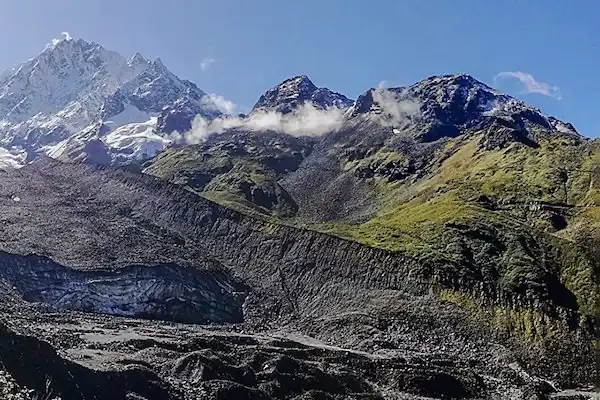Takakia is a tiny, slow-growing moss that can only be found in small patches in the Tibetan Plateau, as well as in the countries of Japan and the US. The researchers undertook 18 expeditions to reach the moss’s 4,000-meter-high home in the Himalayas, collect samples, and study its habitat. “We set out to describe and analyze a living fossil,” says author Ralf Reski, a plant biotechnologist at the University of Freiburg in Germany.
“In the Himalayas, you can experience four seasons within a day,” adds plant biologist and co-expedition leader Ruoyang Hu, a member of the team from Capital Normal University in China. “At the foot of the mountain, it is sunny and clear. When you get to the halfway point, there is always a light rain — it feels like you’re walking in a cloud. And when you get to the top, it snows and it’s very cold.”
“Only half of the road is accessible by drive. We had to climb up the remaining way,” says co-expedition leader and fellow plant biologist at Capital Normal University, Xuedong Li. “We also had to be cautious and vigilant to stay safe at this altitude. Three students got high-altitude sickness in our decade’s research. Thanks to our Tibetan guides, we transferred them to a lower altitude in time to get them medical care.”
Takakia was already 100 million years old when the Himalayas rose up underneath it, altering its habitat dramatically and forcing it to adapt quickly — which it did. “The idea was to go as deep as possible into the history of the first land plants to see what they can tell us about evolution,” says Reski. “We found that Takakia is currently the genome with the highest number of fast-evolving genes. It’s very active on the genetic level.”
The team found that Takakia‘s extensive genome evolved over generations of selection to excel at fixing broken DNA and recovering from UV damage, among other things. “Takakia plants are covered with heavy snow for eight months each year, and then are subjected to high-intensity ultraviolet radiation during the 4-month light period,” says Yikun He, author and fellow plant biologist at Capital Normal University. In response, the plants adapted the ability to grow in different locations using a flexible branching system. “As a result, this continuous branching forms a network structure and a very sturdy population structure, which can effectively resist the invasion of heavy snowstorms.”
Sequencing Takakia‘s genome also helps to end a longstanding debate about its classification. “People wondered, is it really a moss? Or is it something like an alga or a liverwort? Because it has a combination of ancient traits,” says Reski, “but our work shows that it’s a moss.”
While Takakia‘s genome has changed dramatically over time, its morphology has barely changed. “You normally would think, if you have a lot of mutations in your genome, at some point the form would change. We hope these findings will inspire a whole new field of study — evolution involving changing genomes and static morphology,” says Reski.
The team also studied Takakia’s environment using satellite weather data, equipment that studied the plant’s “microclimate,” and timelapse cameras that observed the larger environmental changes occurring in the greater ecosystem. They found that the climate was steadily warming and that the glaciers on the plateau were rapidly melting. They also observed that the moss is experiencing higher UV radiation than ever before. Studies the team performed in the lab showed that the level of UV radiation Takakia now experiences is enough to kill even other plants adapted for harsh environments.
In addition, the researchers noted that despite the moss’s past success in rapid adaptation, it’s becoming increasingly hard to find, even for experts like Li and Hu. In fact, they found that Takakia populations in Tibet decreased by around 1.6% each year over the course of their study. “Our prediction shows that suitable conditions regions for Takakia will shrink to only around 1,000-1,500 square kilometers all over the world at the end of the 21st century,” says Hu. The authors agree that the moss likely won’t survive another 100 years.
To help improve the moss’s chances, the authors suggest educating the public about lesser-known species like Takakia. They also propose an international effort to combine resources so that researchers can continue studying and taking measures to protect the moss, such as cultivating it in a lab.
“Plant scientists cannot sit idly by. We are attempting to multiply some plants in the laboratory and then transplant them to our experimental sites in Tibet,” says He. “After five years of continuous observation, it has been found that some transplanted plants can survive and thrive, which may be the dawn of the recovery — or at least a postponement of extinction — of Takakia populations.”
“People have a responsibility to play a more active role in biodiversity conservation and restoration,” says Hu. “We need to not only focus on those charming animals such as the panda, polar bear, and the white dolphin, but also pay close attention to these rare and little species. They are more vulnerable under climate change, such as our moss Takakia.”
“We humans like to think that we are on top of evolution,” adds Reski. “But the dinosaurs came and went, and so might humans, if we are not careful with our planet. Takakia may die because of climate change, but the other mosses will survive, even if we humans cannot. You can learn a lot from the simplest plants about the history of this planet, and maybe the future.”
Read the paper: Cell
Article source: Phys.org
Image: Geomorphological view of the Takakia field study site near Gawalong East Glacier, altitude 3,800–4,400 meters, at Bomi County, Tibet, China. Credit: Dr. Ruoyang Hu, Capital Normal University, Beijing, China








